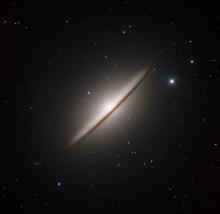Listen to today's episode of StarDate on the web the same day it airs in high-quality streaming audio without any extra ads or announcements. Choose a $8 one-month pass, or listen every day for a year for just $30.
You are here
Beauty and the Beast
A recent discovery by Hubble Space Telescope sounds like a cosmic version of “Beauty and the Beast.” A beastly black hole appears to be leaving a trail of beauty in its wake: a ribbon of bright stars.
Astronomers discovered the system as a small streak of light on a Hubble image. Follow-up observations revealed that it’s more than seven billion light-years away and 200,000 light-years long. There appears to be a hot spot at one end of the streak, and a small galaxy at the other. A trail of young stars connects them.
The team that discovered the system says the hot spot probably contains a black hole up to 20 million times the mass of the Sun. It’s plowing through clouds of gas, heating them and making them shine brightly. The gas flows around the black hole. It cools and condenses, forming new stars.
The black hole might have started its jaunt almost 40 million years ago. Three galaxies merged and their black holes fell toward each other. A complex dance sent one of the black holes careening off into space.
A few months after the initial announcement, though, other astronomers suggested that the system is a lot less exciting. It’s simply a thin galaxy seen edge-on, so it looks like a bright streak of light — beauty without the beast.
Whatever its true nature, the system is in the head of Cetus, the whale or sea monster, which is in the southeast at dawn, close to the brilliant planet Jupiter.
Script by Damond Benningfield





